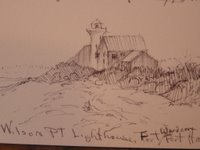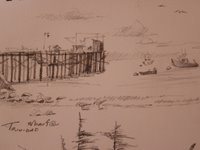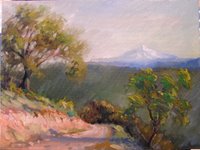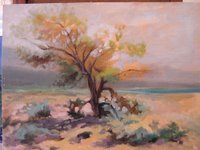
Wilson Pt., Lighthouse is on the elbow of the Olympic Penninsula, Wa where the Strait of Juan de Fuca turns south to become Puget Sound. I was at Port Hadlock for meetings of the Washington PUD Association. I managed to carve out some time early one morning to do some drawing and painting. I did a lot of drawing and watercolors on this trip to Lake Tahoe where I had another meeting of the Northwest Public Power Association. Me and my friend Betts took the long way down and back.
I made a pochade box to keep 10, 12x16 canvas boards that worked well to contain messy oil paintings that would otherwise get all over everything in the car. This painting is on masonite because my order of archival canvas board didn't arrive before I left. I don't like the slick surface of masonite but worked with it to achieve some new effects. The sun came out for a moment at about 5 a.m. and I captured the colors it made on the sky. The wind on the west side of the point where I chose to set up was strong and cold. Just 100 yards to the leeward side the wind abated, so much for choosing a comfortable spot to paint.
It is an interesting area with the remnants of cannon placements made to keep Japanese subs out of the sound. There were 3 forts set up in such a way that a vessel would find it quite difficult to sneak by.
We stayed in Port Townsend which is full of galleries, boutiques, and fine old buildings occupied by the 'fringe' element of artists and creative types. There is also the school of wooden boat building and many vessels moored at the local marina. Betts found the proprietors receptive to the
www.shopthefrontier and intends to follow up some business contacts.

From Port Townsend we traveled by Mt. Hood, Oregon and made our way down to Northern California. Betts loves a good hot tub and when she saw "Hot Springs" we took the next turn and found ourselves following the trail that brought pioneers to California over "Fandango Pass". We discovered an obscure valley of alkali lakes and weren't too impressed until we started seeing some great wildlife. We found the smallest indian reservation I've ever heard of, the 3 mile squarem at Fort Bidwell. The town was absolutely empty. Sheep walked the streets and we discovered a tree full of turkey vultures. I counted more than 30 of them in a cottonwood. I can't imagine what so many vultures found to eat.

We were informed by the local town greeter who was obviously not very far from his bottle of inspiration that the reason for steam vents and hot springs was that there were faults on both sides of the valley but not to worry there hadn't been any earthquakes lately. He was a happy fellow and pointed out our destination. On the way we discovered that the streams in the valley were running hot water and steam rose in the humid air all around the valley. I saw my first Sandhill Crane which were plentiful and quite a common sight as they were eating the newly planted grain of farmer's fields.
From here we headed south to our rendezvous at Lake Tahoe. We weren't looking forward to the interruption of our leisurely tour of the countryside but ended up having a good time in the casinos and learning about the state of affairs of the power industry.





 Wilson Pt., Lighthouse is on the elbow of the Olympic Penninsula, Wa where the Strait of Juan de Fuca turns south to become Puget Sound. I was at Port Hadlock for meetings of the Washington PUD Association. I managed to carve out some time early one morning to do some drawing and painting. I did a lot of drawing and watercolors on this trip to Lake Tahoe where I had another meeting of the Northwest Public Power Association. Me and my friend Betts took the long way down and back.
Wilson Pt., Lighthouse is on the elbow of the Olympic Penninsula, Wa where the Strait of Juan de Fuca turns south to become Puget Sound. I was at Port Hadlock for meetings of the Washington PUD Association. I managed to carve out some time early one morning to do some drawing and painting. I did a lot of drawing and watercolors on this trip to Lake Tahoe where I had another meeting of the Northwest Public Power Association. Me and my friend Betts took the long way down and back.
